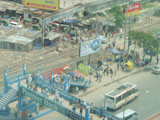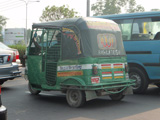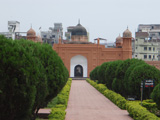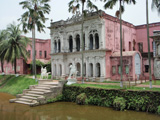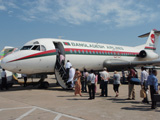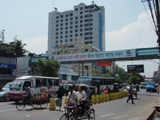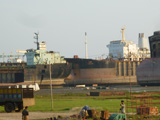The street market is near
Hotel Dhaka Regency
 |
Bangladesh has a surface of 147.570 square Km. and a population of 160 million inhabitants. This is the 7th most populated country in the world with a density of more than 1.000 inhabitants per square Km. The borders of actual Bangladesh have been established with a separation between India and Bengala in 1947, when the region became the oriental portion of the new born Pakistan, even if it was separated by the state on the western side by 1.600 Km. across India. Linguistic, political and economic discriminations, led to popular unrest against Western Pakistan, that had as consequence the war for Indipendence in 1971 and the establishment of Bangladesh State. Nevertheless, the new state had to put up with shortages, natural catastrophies and widespread poverty, and also with political disorders and military coup d'état. The re-establishment of the democracy in 1991 has been followed by relative stability and economical progress.
Bangladesh is one of the most densely populated countries in the world and has a high rate of poverty. Geographically the country is located on the fertile plane of Ganges and Brahmaputra delta, and is subject to annual floodings of monsoons and hurricanes. The population is relatively young, with the age band between 0-25 years that corresponds to 60% of the total population, whereas only 3% has an age over 65. The life expectancy is 63 years for both sexes.
The literacy rate in Bangladesh is around 40%. I was surprised on the plane that some young passengers that were coming back home, asked me to fill up their debarkation documents because they could not read or write. The Bengali language or bangla is the official language of the country and the most used one. English is used as a second language between the media, in the high classes and in the field of higher education.
The main religion in Bangladesh is Islam (97%) and the other 3% belongs to Induism, Buddhism and Christianity. In order to visit the country you must have a valid passport and a Visa that you can purchase at the airport paying 51 USD (the Germans only pay 15 USD). Bangladesh entered the Guinness Book of Records as the 1st Nation in the world for "waste recycling". Here nothing is thrown away, but everything is recycled and every person is specialized in collecting something.
Dhaka |
Dhaka is the capital and is also the biggest town in Bangladesh. Geografically it is located in the centre of the nation. It is a town rich in history and culture, and is internationally known as "the town of the mosques". A trip to Bangladesh cannot be considered complete without a visit in Dhaka. The town is located in a monsoon zone, and this means that it receives a lot of rain every year between May and September during the monsoons' season. These natural conditions make it the perfect place to cultivate rice and juta, and for this reason it can be considered as one of the first countries in the world for the production of these products.
Tourism in not developed at all. Dhaka has a population of about 15 million inhabitants and has very few hotels: the 5-star-hotels belong to the international chains: Sheraton, Pan Pacific, Westin and Radisson. You can find also lower rated hotels, but the level of hygiene is very low. Even taxis are very rare. The yellow cabs have aircon and the taximeter rarely works: it is always necessary to agree on a price. The motor thrishaw, on the contrary, are everywhere and are armoured on both sides for security reasons.
From the international airport of Dhaka to the Pan Pacific Hotel you pay 500/700 taka. The traffic is always very heavy, and during the rush hours you cover 2 Km. per hour. The lack of tourism ensures that you are looked at as if you are a martian...
In town you can visit Lalbagh fort, built in 1678 by prince Mohamed Azam, son of Mughal emperor Aurangazeb who was a viceroy in Bengala.
Among the different temples in town, the National Dhakeshwari Temple (hindu temple) is a government property and was built in the XII century by Ballal Sen, a king of Sena Dynasty. It is considered an essential part of Dhaka heritage, and nowadays it is considered as the most important hinduist site in Bangladesh.
30 Km. from town is located Sonargaon, one of the oldest capitals in Bengala. It was the seat of Seva dynasty till the XIII century. From this period on to the arrival of Mughals, Sonargaon was the secondary capital of Bengala Sultanate. The area has an extension of 56 acres with a foundation of Arts and Crafts and conserves all the instruments of the past; there are some small lakes and bridges that connect all the site. Entrance ticket: 100 taka for tourists, 10 taka for locals.
***** |
Chittagong
Chittagong is the major port and the second town in Bangladesh with 4 million inhabitants. It is located in the south-oriental side of Bangladesh, on the coast of the Bengala gulf, 240 Km. far away from the capital Dhaka. It seems that its name means "at the mouth of Ganges river" according to an etymology referring to the arab word Shat having the word Ganga (Ganges) as suffix. The town is the centre of business and it hosts the biggest companies in the country. The manufacturer division is very developed, in particular the leather manufacture. Other activities concern the juta manufacture, frozen food, whereas among the big industries we point out the car construction and the chemical and pharmaceutical industry. The sea trade concerns cotton, rice, spice, sugar and tobacco. Another activity bound to the port is the ships' demolition (oil tankers, cargos, cruise ships), introduced in 1969. Unfortunately it is not possible to enter the zone where the ships are wrecked, unless you have a special permit from the government. I could take some pictures from outside and from afar. All of the area is surrounded by walls and there is a strict control at the entrance of the different shipyards. Along the roads it is possible to realize of this demolition work as chains, caterpillar engines, kitchens, ladders, tenders etc. can be seen, and everything is recycled.
To go and see this area by taxi from the centre of Chittagong it will cost 1.000 taka (10 €) for three hours. In town the best hotel is the Peninsula Chittagong****, which costs 150 €/night BB. In the nearby you can find Meridian with more affordable prices: from 40 to 50 USD BB. Its address is: 1367, CDA Avenue, Chittagong, Tel. 880-31-654000; e-mail: mhr@meridiangroupbd.com. The airport is 20 Km./30' away and the taxi costs 500 taka. When you arrive at the airport you are overcome by many potential taxi-drivers and it is necessary to discuss the price. They start from 1.700 taka to reach at the end 500.
Even here no tourists at all.
One of the most imposing buildings in town is the Mosque Shahi Jama-e-Masjid.
The traffic is always very
thick and, as Dhaka, there are no rules. All vehicules will continue to drive and to cross the road you must be as quick as lightening if you don't want to collide with a car.
In order to escape from the traffic jam, in the nearby of the zoo, which is really inhuman for those poor animals, is located the Foy's lake, very beautiful theme park,
where you can stroll amid the green hills and the lake. Inside the park, the resort makes available some chalets at affordable prices, mostly for just married couples, allowing them to celebrate their honeymoon in a romantic and peaceful environment. The town is served by a railroad and an international airport. A service of comfortable bus links the capital to Chittagong. The ticket costs 500 taka.
Bangladesh currency : Bangladeshi Taka (BDT)
Change of 18th. April 2011:
1 € = 103 BDT- 1 USD = 74,50 BDT
Time difference with Italy: +4h (legal time)
